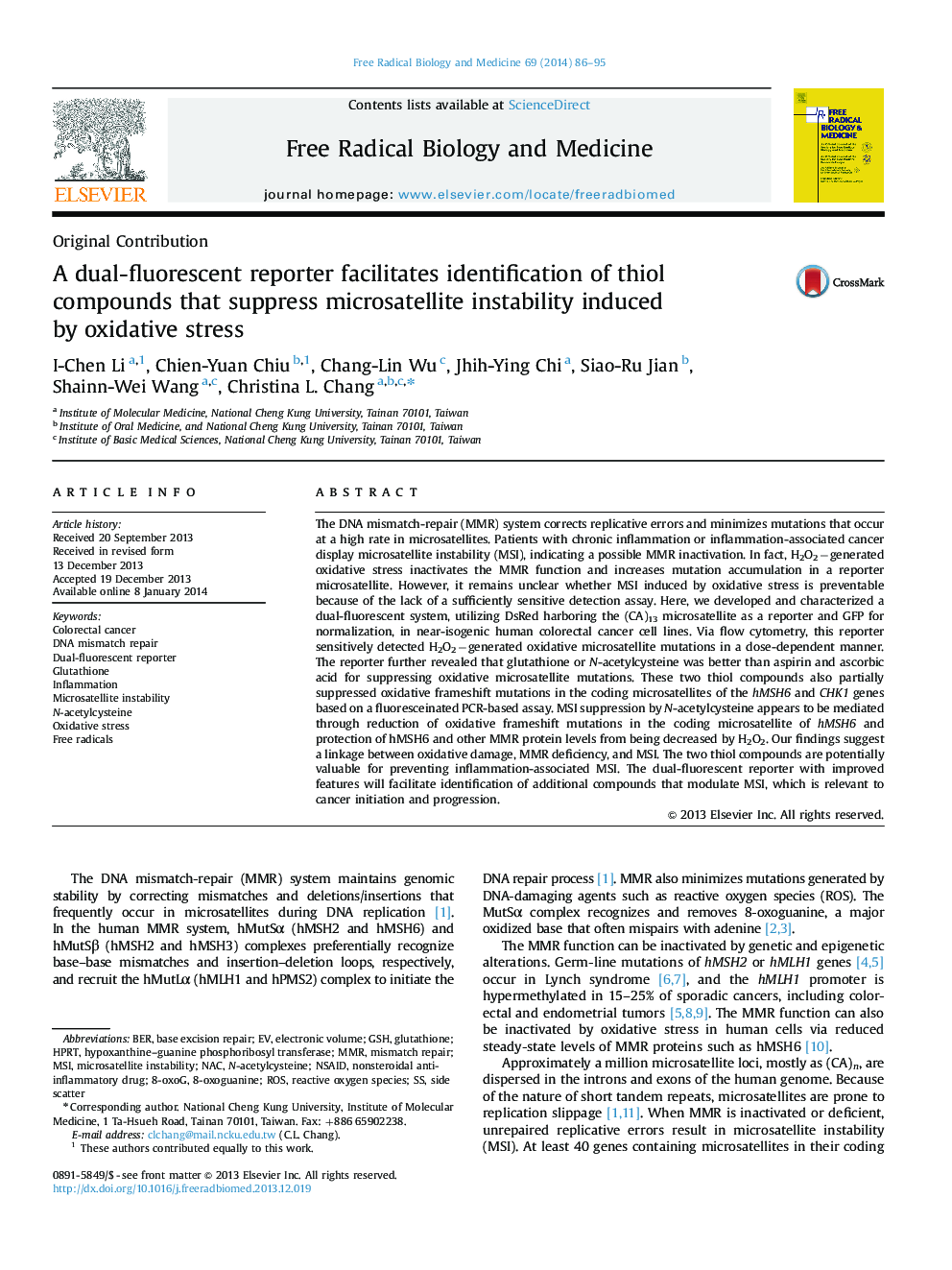| کد مقاله | کد نشریه | سال انتشار | مقاله انگلیسی | نسخه تمام متن |
|---|---|---|---|---|
| 8270477 | 1534973 | 2014 | 10 صفحه PDF | دانلود رایگان |
عنوان انگلیسی مقاله ISI
A dual-fluorescent reporter facilitates identification of thiol compounds that suppress microsatellite instability induced by oxidative stress
ترجمه فارسی عنوان
یک گزارشگر فلورسنت دوگانه شناسایی ترکیبات تیوول را که موجب بی ثباتی میکروسله ردی شده ناشی از استرس اکسیداتیو می شود، تسهیل می کند.
دانلود مقاله + سفارش ترجمه
دانلود مقاله ISI انگلیسی
رایگان برای ایرانیان
کلمات کلیدی
NAChypoxanthine–guanine phosphoribosyl transferaseHprt8-oxoGMMRMSIBERGSHNSAID8-oxoguanine - 8-اکسوگوینینN-acetylcysteine - N-استیل سیستئینROS - ROSinflammation - التهاب( توروم) Microsatellite instability - بی ثباتی ریزماهواره ایmismatch repair - تعمیر ناسازگاریDNA mismatch repair - تعمیر ناسازگاری DNAbase excision repair - تعمیر پایه پایهOxidative stress - تنش اکسیداتیوnonsteroidal anti-inflammatory drug - داروهای ضد التهابی غیر استروئیدیFree radicals - رادیکال آزادColorectal cancer - سرطان روده بزرگside scatter - پراکندگی سمتGlutathione - گلوتاتیونReactive oxygen species - گونههای فعال اکسیژن
موضوعات مرتبط
علوم زیستی و بیوفناوری
بیوشیمی، ژنتیک و زیست شناسی مولکولی
سالمندی
چکیده انگلیسی
The DNA mismatch-repair (MMR) system corrects replicative errors and minimizes mutations that occur at a high rate in microsatellites. Patients with chronic inflammation or inflammation-associated cancer display microsatellite instability (MSI), indicating a possible MMR inactivation. In fact, H2O2âgenerated oxidative stress inactivates the MMR function and increases mutation accumulation in a reporter microsatellite. However, it remains unclear whether MSI induced by oxidative stress is preventable because of the lack of a sufficiently sensitive detection assay. Here, we developed and characterized a dual-fluorescent system, utilizing DsRed harboring the (CA)13 microsatellite as a reporter and GFP for normalization, in near-isogenic human colorectal cancer cell lines. Via flow cytometry, this reporter sensitively detected H2O2âgenerated oxidative microsatellite mutations in a dose-dependent manner. The reporter further revealed that glutathione or N-acetylcysteine was better than aspirin and ascorbic acid for suppressing oxidative microsatellite mutations. These two thiol compounds also partially suppressed oxidative frameshift mutations in the coding microsatellites of the hMSH6 and CHK1 genes based on a fluoresceinated PCR-based assay. MSI suppression by N-acetylcysteine appears to be mediated through reduction of oxidative frameshift mutations in the coding microsatellite of hMSH6 and protection of hMSH6 and other MMR protein levels from being decreased by H2O2. Our findings suggest a linkage between oxidative damage, MMR deficiency, and MSI. The two thiol compounds are potentially valuable for preventing inflammation-associated MSI. The dual-fluorescent reporter with improved features will facilitate identification of additional compounds that modulate MSI, which is relevant to cancer initiation and progression.
ناشر
Database: Elsevier - ScienceDirect (ساینس دایرکت)
Journal: Free Radical Biology and Medicine - Volume 69, April 2014, Pages 86-95
Journal: Free Radical Biology and Medicine - Volume 69, April 2014, Pages 86-95
نویسندگان
I-Chen Li, Chien-Yuan Chiu, Chang-Lin Wu, Jhih-Ying Chi, Siao-Ru Jian, Shainn-Wei Wang, Christina L. Chang,
